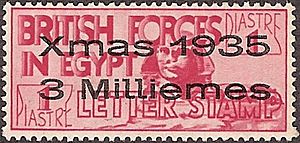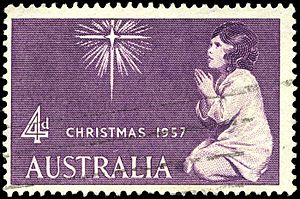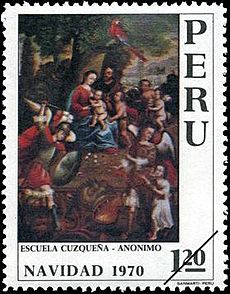Christmas stamp facts for kids
A Christmas stamp is a special postage stamp that has a Christmas picture or theme. People use these stamps mostly for sending seasonal mail, like Christmas cards, to friends and family. Many countries around the world print these stamps. They are real postage stamps, not like Christmas seals, and you can usually use them all year. Some countries sell them at a lower price, but only for Christmas cards. These stamps usually go on sale between October and December and are printed in huge numbers.
Contents
History of Christmas Stamps
It's a bit of a puzzle to figure out which was the very first Christmas stamp.
Early Christmas Stamp Ideas
The Canadian map stamp from 1898 has "XMAS 1898" written on it. However, this stamp was actually made to celebrate the start of the Imperial Penny Postage rate. The story goes that the Christmas link happened by chance. A man named William Mulock wanted to release it on November 9th to honor the "Prince." When Queen Victoria asked "what Prince?" he quickly replied, "Why, madam, the Prince of Peace."
In 1935, British soldiers in Egypt got a special Christmas stamp. They used it for sending mail back home. For many years, stamp catalogs didn't list these. They thought they were just "seals." But now, they are seen as real stamps. This is because they paid for postage. So, many people believe these were the first stamps made just for Christmas.
First Official Christmas Stamps
In 1937, Austria released two "Christmas greeting stamps." They showed a rose and zodiac signs. Then, in 1939, Brazil issued four special stamps. These stamps helped raise money for charity. Their designs included the three kings, an angel with a child, and a mother with a child. In 1941, Hungary also released a stamp to help soldiers at Christmas. The first stamps to show the Nativity scene were from Hungary in 1943. These early stamps were often one-time issues, like commemorative stamps.
Christmas Stamp Traditions Begin
More Christmas stamps started appearing in 1951. Cuba issued stamps with poinsettias and bells. After that, Haiti (1954), Luxembourg and Spain (1955) followed. Then came Australia, South Korea, and Liechtenstein in 1957. For countries like Australia, this was the start of an annual tradition. Many more nations began issuing Christmas stamps in the 1960s. This included the United States (1962) and the United Kingdom (1966).
By the 1990s, about 160 postal services were issuing Christmas stamps. Most of them did it every year. Most Islamic countries do not issue Christmas stamps. However, the Palestinian Authority has issued them since 1995.
Christmas Stamp Designs
Most Christmas stamps are "working stamps." This means they are used a lot to send greeting cards. So, they are usually normal-sized. They come in one or a few values to cover different postage costs.
Types of Designs
The designs on Christmas stamps vary a lot. Some show religious images, like the Nativity. Others show non-religious things, like Christmas trees, wreaths, or Santa Claus. A country might use the same theme for several years. Then, they might change it completely. Sometimes, they follow trends from other countries. For example, in the 1970s, many countries used children's drawings on their Christmas stamps. The young artist's name and age were often included.
Choosing Designs: Religious vs. Secular
Choosing between religious and non-religious designs can be a big discussion in some countries. Church leaders often feel that non-religious designs make the holiday less meaningful. On the other hand, postal officials worry. They fear that very religious designs might make some customers avoid the stamps. This could leave millions of stamps unsold. It could also lead to accusations that the postal service is promoting one religion.
In the United States, this debate was solved. The Postal Service now issues both types of designs each year. They usually release a group of 4–6 related non-religious designs. They also release one religious design, often showing the Madonna and Child. To avoid problems, these religious designs are often taken from Old Master paintings. These paintings are usually found in U.S. art galleries. This way, the stamps are seen as showing art. In the United Kingdom, the Royal Mail solves this by switching. They issue religious designs one year and non-religious designs the next.
How Christmas Stamps Are Used
People usually use Christmas stamps to quickly put them on many Christmas cards. In today's world of email, Christmas stamps might be the most stamps some people use all year. It's common to see leftover Christmas stamps on regular mail in the new year. In Australia and the Netherlands, Christmas stamps are sold at a discount. You can still use them after Christmas. You just need to add more stamps to make up the correct postage rate.
Collecting Christmas Stamps
Collecting Christmas stamps is a popular hobby. It's part of topical collecting, where you collect stamps based on a theme. Because so many are printed, most Christmas stamps are easy to find. They also don't cost much money.
Collecting Challenges
The real challenge for collectors is finding special items. For example, they look for envelopes with unique postal markings. This could be a postmark from Christmas Day itself. Not all post offices are closed that day! Or, a postmark from a special place. Some examples are Christmas Island, Christmas, Florida, North Pole, Alaska, or Santa Claus, Indiana. Collectors also look for stamps with specific Christmas themes or slogans.
The Christmas Philatelic Club started in 1969. It's for people who collect Christmas stamps. They publish a quarterly magazine called the Yule Log. Some collectors see Christmas collecting as a part of collecting stamps about religion.
Other Holiday Stamps
The United States has also issued stamps for other holidays. These include Thanksgiving and New Year's Day. Since the 1990s, stamps for Kwanzaa, Hanukkah, Eid, and Chinese New Year have become regular. These designs are often used for several years. Only the stamp's value or year changes.
In Japan, there is a long tradition of a New Year's stamp. Some Easter stamps have also been issued. However, these are mostly made for collectors. Valentine's Day stamps are a newer tradition in some countries.






